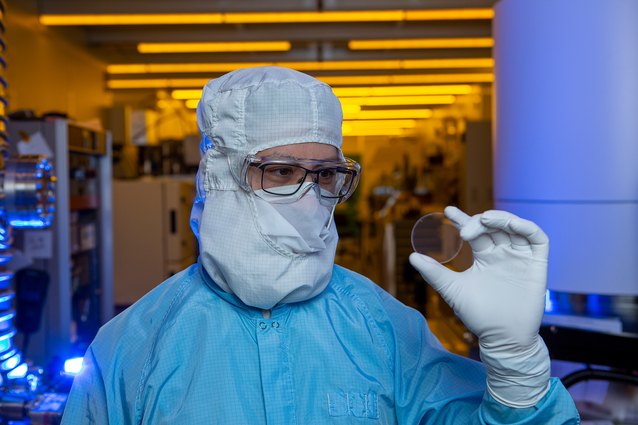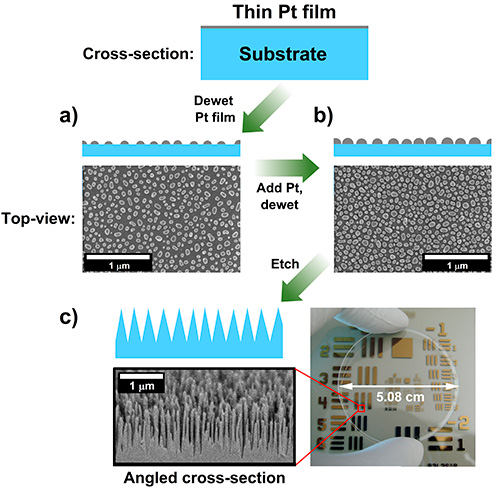Advanced masking technology enables new applications for metasurface optics
 (Download Image)
(Download Image)
Standing in LLNL’s Center for Micro Nano Technology, Nathan Ray holds a marvel of optical engineering, a 5-centimeter metasurface optic with deep, closely spaced surface features that allow for a wide optical bandwidth and a large span of incidence angles for an antireflection layer. Photo by Jason Laurea/LLNL.
Optics researchers at Lawrence Livermore National Laboratory (LLNL) have refined their novel metasurface process to create taller features without increasing feature-to-feature spacing, an advance that unlocks exciting new design possibilities.
“We have refined our process to create metasurfaces that allow for a wide optical bandwidth and a large span of incidence angles for an antireflection layer,” said LLNL research scientist Eyal Feigenbaum, the principal investigator. “We can now cover bandwidth range all the way from the ultraviolet to wavelengths larger than 2 microns, which is extraordinary. That wasn’t possible with the existing technology.”
The result is reported in a new paper, “All-Glass Metasurfaces for Ultra-Broadband and Large Acceptance Angle Antireflectivity: from Ultraviolet to Mid-Infrared.” It will be the cover story for the December 2023 issue of Advanced Optical Materials.
Metasurface is an approach to optics design in which the surface of a material is carefully altered, creating an ultrathin “metasurface” with properties that differ from those within the bulk of the material by introducing features smaller than the optical wavelength. Feigenbaum’s team have been developing a scalable process for engraving metasurfaces into fused silica glass, part of a Laboratory Directed Research and Development project ending this year.
The LLNL method seeks to replace the need for broadband anti-reflective (AR) coatings with a metasurface that is monolithic to the optic — essentially becoming a seamless part of the optic — to enhance its endurance and stability. Furthermore, the team has presented and continues developing different alterations of this method for implementing sub-micron thick optical elements, such as lenses, and polarization altering waveplates.
For the National Ignition Facility (NIF) and other advanced laser systems, such metasurface optics could be transformative, replacing multiple optics with a single, more robust, slimmer optic.
Their four-step process, consisting of ultrathin metal film deposition, dewetting, etching and mask removal, results in an all-glass metasurface. While relatively simple, the process provides substantial tunability and control over metasurface features. Their most recent advances came from two significant changes to their process: changing the deposition material from gold to platinum, and advancing the dewetting mask technology.
“This is what allowed us to etch deep features while maintaining the same feature spacing,” said LLNL staff research scientist Nathan Ray, the lead author of this study.
The challenge in producing a metasurface that operates over a broad band of wavelengths is manufacturing a feature height-to-width aspect ratio that is large enough. For that purpose, the nanofeatures' widths and spacing must be made smaller than the shortest wavelength, while the depth of the nanofeatures must be close to half of the longest wavelength in the band of operation.
The metasurface fabrication process: a) Thin films of platinum (Pt) were deposited and dewet on a 2-inch-diameter fused silica substrate, generating an ensemble of platinum nanoparticles to function as an etching mask. b) This process was repeated to build up the mask. c) Reactive ion etching (RIE) was used to etch the mask/substrate system to generate the structure depicted by the angled cross-section electron image; the process was repeated on both surfaces.The team invented a technique they call “seeded dewetting,” which allows increasing the mask nanoparticle height while maintaining the inter-particle spacing. For the metasurface to function as an AR, the inter-particle spacing must be substantially smaller than the light wavelength, yet the height of the mask nanoparticle determines how tall the metasurface features can be made.
Traditional dewetting has a limited design space, since an increase in the nanoparticle height goes hand-in-hand with an increase in the inter-particle spacing. The researchers found that seeded dewetting, or subsequent depositions and dewetting of ultrathin metal film on top of preexisting nanoparticle “seeds,” maintains the original inter-particle spacing while each step steadily increases the height due to metal accumulation around the initial nanoparticle seeds.
Using this advanced mask technology, they were able to create metasurfaces with nanoscale all-glass metasurface features with height-to-width ratio as large as about 14, where the mean base diameter of the cone-like features is 62 nanometers. They demonstrated this metasurface on both sides of a 2-inch-diameter fused silica window.
The AR performance of such an optic is capable of eliminating reflected light over unprecedented wavelength ranges covering ultraviolet, visible, and infrared, both P- and S-polarizations, and a broad range of acceptance angles. Such optics could enhance the efficiency of light delivered through protective windows of photovoltaic cells, the throughput of multiharmonic lasers, and laser systems that combine beams from different angles or that dynamically vary the beam direction over large angular spans.
“This technology could be transformative for solar-cell windows,” explains Ray. “Using current AR technologies on protective window coverings for solar cells, the efficiency of the AR coating depends on the angle it makes with the sun and the wavelength of the incident light, and is polarization dependent. The metasurface optic we demonstrated works for a wide range of angles — so there is no need to move the cell — handles both polarizations, and demonstrates near-negligible reflection over the entire solar spectrum.”
Metasurface optics using this technology could enable a broader design space for the variety of lasers developed for and operated at LLNL, with monolithic antireflective coatings also providing robustness and endurance for use with high-powered lasers.
The researchers are now working to tailor the AR to specific applications, apply the methodology to substrates beyond the fused silica glass used to make many of NIF’s optics, and increase the scale. Two inches is large in the world of optics, but quite small in comparison to those found in NIF.
Co-authors on the paper included Feigenbaum, Ray, and fellow LLNL scientists Jae-Hyuck (Jake) Yoo and Hoang T. Nguyen.
Contact
 Patricia Koning
Patricia Koning
[email protected]
(925) 423-4332
Related Links
Laboratory Directed Research and DevelopmentTags
Advanced Materials and ManufacturingMaterials Science
Lasers and Optical S&T
Lasers
National Ignition Facility and Photon Science
Physical and Life Sciences
Featured Articles








